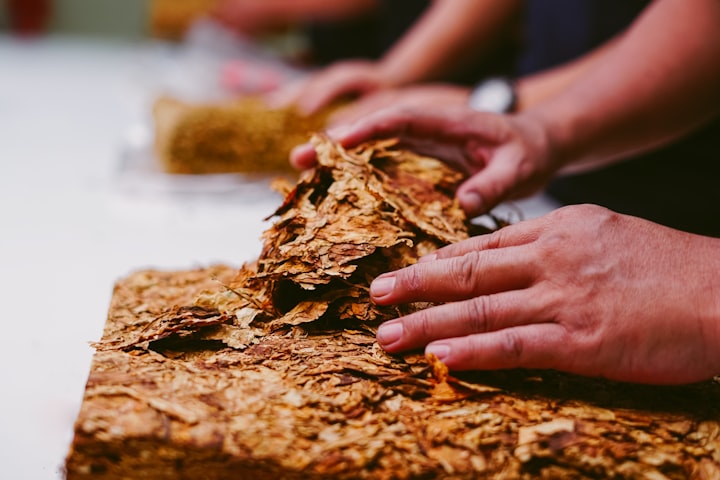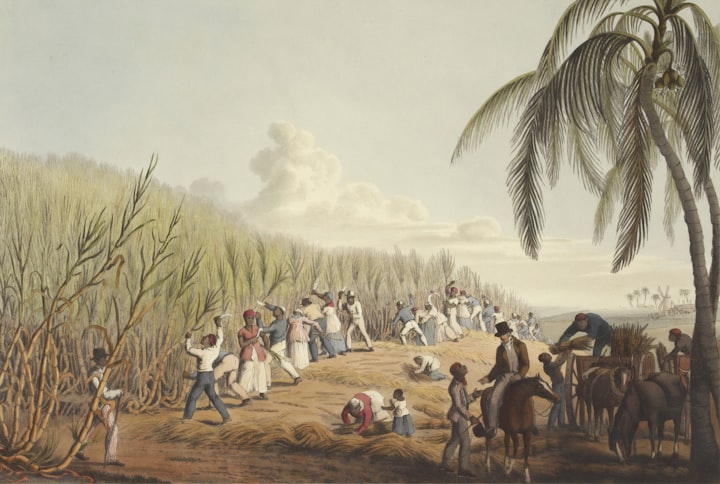The History of Tobacco in Florida
Tobacco's Origins in the Sunshine State

The scientific name for Tobacco is Nicotiana tabacum, and is in the same family of Solanaceae, which includes tomatoes, peppers and potatoes. Tobacco is characterized by the presence of the alkaloid nicotine which is found in all parts of the plant except the seed. The production of Tobacco has been a staple in Florida’s history and foundation long before the Civil War. Quincy, Florida grew a great deal of what was known as “Speckled leaf tobacco”, a sun variety grown on hammock land. This tobacco was hauled by wagon to the gulf port of St. Marks and transshipped by sailboat, about one-third of the annual yield being exported. This pristine industry reached its end in the Civil War, with only a few believers who were too conservative and stubborn to allow a war to interfere with the accepted order of their lives.
Gadsden County, FL is widely known for manufacturing of shade tobacco. Shade tobacco was the county's first big industry and an important crop in Florida. There were only two locations in the United States that was suitable for the growing of this crop which was used to wrap cigars; the "Georgia-Florida Shade Tobacco District" comprised of Gadsden and Madison counties in Florida and Grady and Decatur counties in Georgia and the Connecticut River valley in New England. In 1946, these two districts were producing over 95% of American-grown wrapper leaf and they represented a $100,000,000.00 industry of which $25,000,000.00 was invested in land equipment, barns, packing houses, and operating capital in the Georgia-Florida area. Total acreage devoted to the plants ranged from 6072 at the peak to 344 in 1977.
Today shade tobacco is grown only in the Connecticut River valley and shade tobacco barns are most often seen in paintings and photographs as few are still standing. In 1929, the Legislature, impressed with the tobacco research, agreed to expand the research to other agricultural endeavors. During that year, 617 acres located 3.5 miles from Quincy was acquired to expand the tobacco research and to initiate general field crops and livestock investigations. Plant nurseries have taken the place of shade tobacco as the leading agricultural industry in the county.
In 1850 almost a million pounds of tobacco was grown in Florida and almost 800,000 pounds of the crop came from Gadsden County. An estimated 1,200,000 pounds was produced in Gadsden county by 1865. The crop prospered for over a decade, but by 1874 it reduced to about 200,000 pounds. By 1886 the tobacco industry began to use Cuban tobacco seeds on upland and hammock soil, which resulted in a moderate amount of cigar filler and the increasing growth of wrappers on fresh hammock land was found to be a greater profit and began to receive more attention.
By 1887, an abundance of big companies emerged all over the area and purchased numerous amounts of land for tobacco farming. There were several high-profile tycoons who began their own business, most notably George L. Storm and William M. Corry, who partnered and formed the Owl Cigar Company. Throughout the 1890s, the OCC had a labor force of 500, consisting of mostly Alsatian Germans. The Alsatians evaluated gray clay as Fuller’s Earth (a filter and a catalyst) known to them in their country while digging a well on the property. The discovery resulted in the creation of a new industry in the area.
There was an elaborate experiment in tobacco culture that was destined to revolutionize the cigar wrapper industry of the world-the first attempt to grow tobacco under shade. This experiment was the result of an inherent feeling on the part of one of the growers that a more delicately textured leaf would be produced by the protection of the growing tobacco from the powerful rays of the sun and the consequent conservation of the moisture so essential to successful tobacco growth, this grower having noticed that tobacco partly shaded by trees was of a higher quality than that entirely unprotected.
The innovation was an immediate and a pronounced success, the first shade tobacco sold for more than $4 a pound, as against an average price of forty cents a pound for the sun variety. There were two systems of innovation. One was the distribution of water, steam and gasoline power through relatively small ditches. The culture of tobacco under shade in Gadsden County, Florida, began in 1889. Since then it has been the practice to grow tobacco on the same land year after year for indefinite periods; that is, the continuous-culture system is employed. In contrast with this, it is the practice in some other tobacco-growing sections to grow only one or two crops of tobacco on the land and then to allow a period of several years to elapse before cropping to tobacco again. There is usually a good reason on the part of growers for adopting any one system. In some sections the cultural practices are determined by the area of land available and the type of tobacco grown. In the shaded section of Florida and Georgia the great overhead expense of constructing shade is the main reason for practicing the continuous-culture system. Because of the short life of the shade material, especially the cloth used in combination with the slats, the high initial outlay is distributed over only a few years.
Furthermore, no other crop has as yet proved to be as profitable under the shade as- tobacco, so it is the practice to grow this crop year after year as long as the land will yield favorable returns. While another way was distributing water through pipes and sprays, which cost $400 per acre which was significantly greater than the $50 per acre with the ditch method. The other system widely known as the agricultural system was vital as it included harvesting, planting and cultivation. It was similar to the previous agricultural system in the antebellum era with only a single difference-paid labor.
Workers of all ages and genders worked under and hierarchy from crew to foremen to superintendents to a general manager. Although wages were arguably crude compared to today, salaries for a 14- hour work day had a system. The salary for kids ranged from 15 to 25 cent, women 30 to 40 cents, men 20 to 50 cents and foremen, 60 cents. However, the wages at that were sufficient to the workers and it made hospitable lives, despite the hourly pay being far from the level of a dollar.
During the spring of 1896, Dr. Alexander Shaw constructed a wooden shade over a quarter acre of tobacco on a western farm in Quincy, FL. (Payne). Shaw was a descendent of one of the oldest pioneer families in Gadsden county. With his contribution the shade industry was born and created the foundation of modern, all-purpose shade structures seen today. By 1898, wealthy tobacco consumers from all over the county arrived in Gadsden county with limited knowledge of “Shade” or the culture of tobacco. Shade tobacco, was used to wrap cigars and growth was exceptional in the region’s humid climate, and would eventually become the county’s most financially successful industry. Prior to the Civil War, plantation owners in the area relied on slaves to cultivate large quantities of not only tobacco, but also cotton, sugarcane, and corn. In the uncertain post-war economy, shade tobacco emerged as Quincy’s staple crop and the town soon became known as the “shade-grown leaf-tobacco material that attracted the spectators was “brown gold” that was grown under the shade and learned that all that glitters is not gold.
By 1907, shade acreage was the largest but poorest crop in history. This is because there were inexperienced growers who knew very little about maintaining the massive flow of tobacco, and scarcity of shade materials and land to support the growth. The decline eventually led to the imminent collapse of the “brown gold” boom during the fall season. The days of pioneering shade ceased to exist as a new era emerged when the 12 prominent tobacco companies and American Sumatra Tobacco (AST) corporation merged in 1910, resulting the biggest producer of cigar tobacco leaf in the world.
Starting from 1910 until the end of the 20s, the AST soared and thrived. Growing tobacco was nearly effortless as Gadsden grew almost 3,000,000 pounds of shade tobacco which was worth $2,000,000 at the time. The demand for the product exceeded the expectations of its manufacturers, however, disaster struck when a plant disease known as “Black Shank” or blachshank made several consumers ill and the entire company of the AST was close to bankruptcy because of the disease.
In order to restore order to its tobacco supply. The Florida legislature established a tobacco experience station and with the aid of growers, a brand-new form of tobacco plant was created. This new plant was resistant to the horrific disease and possessed admirable qualities that the wrapper leaf had not produced. The new tobacco was made by single plant that was found in a contaminated field. This discovery is among the most complex within the mysteries of tobacco. Despite the mystery the new tobacco saved the AST and helped it evolve from a 2-million-dollar industry into a multimillion dollar industry.
However, the recovery was a slow process and the Great Depression only made it harder, but the tobacco industry braved through the hardship and ultimately experienced the most glorious era of its 150-year foundation. The cigar industry prospered in Florida during the early decades of the 20th century. But a combination of factors caused the industry to decline, as time moved forward. Conflicts between organized labor and factory managers slowed production, while new machines were able to turn out cigars much faster and cheaper than the hand-rolling method. Demand for fine cigars decreased during the Great Depression, and by the end of World War II enough cigar factories had closed to make the industry less attractive for returning veterans.
The cigar industry changed the cultural landscapes of cities like Tampa and Key West. Historic districts still feature buildings once dedicated to the art of the hand-rolled cigar, and local histories still count the industry as a critical influence. The tobacco was further shaded by the addition of cheese cloth to the wooden slats, so that today Florida Sumatra leaf tobacco compares favorably in texture and quality with the imported variety.
In 1946, the U.S. Tobacco Cooperative was formed, and it administered the federal price support program for flue-cured tobacco. It has now reached a settlement in a recent class action that alleges that the cooperative accumulated reserve funds over the years through members who should now receive a portion of those funds, that the purpose for which the cooperative was formed no longer exists, so that it should be dissolved, and its assets distributed to members, and that the cooperative acted unfairly in trying to eliminate some members’ equity interests. Flue-cured tobacco is harvested by priming or picking the leaves from the stalk. The method extends the harvest season much longer than the stalk cutting method used in many other types of tobacco.
Harvesting of flue-cured tobacco by priming should be done as soon as the bottom leaves begin to develop a yellow color, which generally occurs in seven to ten days after flower buds begin to show. Tobacco that is primed before flower buds develop immature and lacks the necessary quality characteristics of good tobacco. The individuals who remove the leaves from the stalks are called croppers.
By using a harvester, the cropper places the tobacco leaves into the fingers on the conveyor chain and the stringer removes the tobacco from the conveyor, thus eliminating the hander and the tobacco is strung. Tobacco harvesters are now being used more, both on the farm and in custom operations. Flue-cure tobacco gets its name from the way it is cured. The employment of the flues, or pipes transport or circulate the heat within the barn gave rise to the name flue-cured tobacco.
The culture of flue-cured tobacco was introduced to northern Florida in 1924. Most amounts of flue-cured tobacco were used in cigarette production, while more massive types were used for granulated smoking tobaccos and snuff. Since then the acreage skyrocketed making the crop successfully grow types of soil, especially around the Suwannee Valley and the southern area Hernando County. The yield per acre and price obtained on the markets for this kind of tobacco produced in the state are positive with the crop being produced in both Georgia and the Carolinas. The cigarette grades of Florida bright leaf are considered by the big tobacco companies as equal or superior to any produced in the United States.
By 1945, with the use of a crop control program, there were a total of 20,000 acres of flue-cured tobacco in Florida, with an absolute value 6,441,000 dollars. The growing of flue-cured tobacco depends on the type of soil, which is a very important factor in the production of creating satisfying cigarettes with grade a quality. The integrity of the soil has a major influence on the color of the leaf as well as the other imperative qualities such as texture, richness and weight. The color is a definitive factor of cigarette tobacco, as a bright yellow hue should be the primary shade. However, the yellow color is impossible to produce in heavier soils, thus making the leaf heavy and prickly.
On May 12, 1933, the Agricultural Adjustment Act was passed for the sole purpose of establishing and maintaining the balance between the consumption and production of agricultural commodities. A Tobacco section was set up soon after the Agricultural Adjustment Administration (AAA) was initiated, and rigorous work began to help the tobacco grower under the provisions of the Act. Dr. G. W. Forster, Head of the Department of Agricultural Economics of North Carolina State College. Forster was summoned to Washington in early July so a preliminary program for flue-cured tobacco could be prepared. Dr. Forster’s plan was highly calculated as it provided a system of three payments to growers who would agree to reduce their acreage in conformance with the requirements set by the AAA.
This plan was able to reestablish prices to farmers at an exceptional level that gave agricultural materials a purchasing power with articles that farmers could buy, thus equalizing the purchasing power of agricultural commodities in the base period. The base period for tobacco ran from August 1919 through July 1929. Throughout the decade, provision was made for reduction in production through tariffs or benefit payments to producers who would cooperate in a reduction program.
Distribution of other provisions of the Act resulted marketing agreements between the Secretary of Agriculture and mediators, associations of producers, and other firms engaged in the handling in the current of interstate or foreign commerce of any agricultural product or and for the issuance of licenses by the Secretary of Agriculture, "as may be necessary to eliminate unfair practices or charges that prevent or tend to prevent the effectuation of the declared policy and the restoration of normal economic conditions" in handling of agricultural products in interstate and foreign commerce”. Funds for carrying on the program were to be derived from processing taxes.
The U.S. Federal Cigarette Labeling Act of 1965 required warning labels to be placed on all cigarette packages. After four years the Public Health and Smoking Act of 1969 required that all cigarette packs contain the statement When the federal government began testing cigarettes for tar and nicotine in 1967, it revolutionized smoking, launching the era of "light" cigarettes. The cigarette companies began competing for a "healthier" cigarette. Philip Morris first marketed Marlboro Lights in 1971, at the time inventing the word "lights" as a descriptor for its cigarettes most of them have been sold in the United States were designated as "light" or "ultra-light". By 2000, these brands constituted 82 percent of the market share.
While these cigarettes were marketed to appeal to health concerned smokers, the supposed health benefits and risk reduction from smoking light cigarettes was never realized. In fact, scientific studies have shown that smoking lights or ultra- lights had little or no health benefit. When the federal government began testing cigarettes for tar and nicotine in 1967, it revolutionized smoking, launching the era of "light" cigarettes.
Tobacco smoking is dangerous, and there is much evidence to support this claim. Each year, tobacco is cited as a contributor to the deaths of close to a half a million people within the US and to a higher figure around the world. The number of people who die from complications that can be traced back to the consumption of tobacco is higher than the number of deaths from alcohol, aids, illegal drugs, and fires combined. Tobacco is, therefore, arguably the leading cause of preventable deaths in America and, indeed, in many other parts of the world.
Tobacco is a slow and fatal killer. This is because smoking tobacco does not result in immediate death, instead the substance gradually eradicates the health of the individual who smokes it. The terrible health effects that have been related to smoking tobacco include having bad breath, wrinkled skin, hair and clothing stench, and the staining of the teeth and nails. Even though most of these side effects are not life threatening, lung cancer and other serious health conditions that have been associated with tobacco smoking, and as a result, numerous deaths have occurred around the world.
A huge concern about tobacco use is that it not only affects the individuals who smoke but also individuals who are around those who smoke. The effects of second-hand smoke can even be more significant than for the actual smoker. The lungs are damaged from the harmful gases emitted from the tobacco products. A suitable number of the individuals who smoke tobacco do not have an idea of what they are smoking because apart from the nicotine, there are many other toxic compounds that are included in the smoke that they are inhaling. When the compounds enter the lungs, they are absorbed into the blood stream which then transports them to body organs such as the heart, spleen, liver, and the central nervous system.
People even contract brain cancer that develops in the lungs and then spreads to the brain. Cigarette smoke contains fast acting compounds that immediately stimulate the central nervous system, which is what causes feelings of pleasure for the smokers. Smoking is initiated as a gateway of administration for recreational drug use because the combustion of the dehydrated plant leaves vaporizes and transports active substances into the lungs where they are absorbed into the bloodstream and reach bodily tissue. While feeling the pleasure, the other compounds slowly and progressively affect the functioning of the body organs in what eventually results in deadly diseases that cause the eventual death of the individual.
The second-hand smoke inhaled by those who are around tobacco smokers is especially dangerous to unborn children, infants, children, and those with respiratory illnesses. When pregnant woman smokes cigarettes or is frequently exposed to secondary tobacco smoke, the smoke gets to the unborn baby and may later result in conditions such as sudden infant death. Whether it is by smoking or by inhaling secondary smoke, tobacco use is, without doubt, hazardous, as illustrated by the numerous diseases and eventual fatality that are connected.
Tobacco has been a staple product of Gadsden County Florida for nearly two centuries. The history of shade tobacco is highly complexed with growth of the beautiful and beneficial cigar leaf will always be known as the industry where the “rich die poor”. It bought prosperity and hardship since its introduction, and it has made Gadsden County a treasure among historian, the treasure being the shade tobacco heritage. The old tobacco barns in the outskirts provide major pluses to the county’s historical significance, as the farming product was a major factor to Florida’s success. Tobacco barns give a worth-while group of phenomena for investigation by settlement geographers. Overall, the legacy of tobacco will live on in Gadsden County’s history books for the next 50 years for other generations to learn why this crucial and profitable resource was the highlight of this county’s success.
About the Creator
Kylecovey Smith
Historian, Linguist, Author (Voyages of the 997 & The Method Mission), YouTuber/TikToker (Master Mojo) and now Vocal writer enjoy and critique my writing as please.






Comments
There are no comments for this story
Be the first to respond and start the conversation.